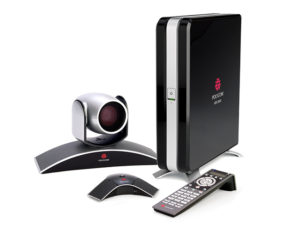Video vendors must make the difficult transition from selling “boxes” to selling and supporting cloud-based solutions. One of the major, enterprise players in video collaboration impacted by these changes is Polycom. The company appears to be leaning into the cloud trend while making strides in the hardware endpoint video conferencing market as well. Polycom recently made an acquisition deal with Mitel, only to ultimately go back and sell to Siris. We are still waiting to see the impact of that deal on their technology and market position but it is yet another sign that Polycom is making a big name for itself in the collaboration field.
Polycom’s Backstory
Polycom has been a big player in the video collaboration market since their pivotal acquisition of ViaVideo in the early ‘90s. They made their mark in enterprise collaboration by selling traditional video conference room technology, video hardware endpoints and audio conference phones. Polycom’s customer base includes enterprises as well as organizations with telehealth deployments and video-enabled classrooms for distance learning in higher education. However, as enterprises have slowly but surely shifted unified communications to private and public cloud, Polycom’s value proposition has dulled a bit.
Another hurdle for Polycom kicked in when VCaaS providers made the need for purchasing video conferencing infrastructure obsolete. These solutions have historically had a negative impact on Polycom – who largely made it’s name selling “boxes” rather than solutions to large enterprises. But Polycom isn’t going down without a fight.
In 2015, Polycom focused efforts on strengthened their own VCaaS solution, Microsoft Skype for Business integrations with RealConnect® and video-enabled audio conferencing endpoints.
Polycom Fights Back
The workplace of the future is filled with millennials, or “digital native,” end users who are not using desk phones, audio conferencing or email as much as the traditional users. Instead, these users prefer real time communications at the enterprise level. For instance, think of popular tools like Slack, HipChat, Google Hangouts and how pervasive they have become in the large organizations.
Current reports and projections indicate a huge demand for visual communication, which is a great thing for Polycom. They already have a large enough presence in the market leaving them plenty of room to compete – if they have the right technology. However, in order to get the attention and add value in the eyes of enterprises, collaboration tools need to interoperate with each other regardless of vendor.
Polycom can make a comeback. They have a strong Microsoft Skype for Business portfolio, and Microsoft is dominating a majority of the enterprise market. However, they will need to get creative with their hardware endpoint offering, as well as provide a solution flexible enough to support cloud and hybrid video conferencing.
The Impact of the Huddle Room Explosion
Polycom has the competency and mindshare in the industry to take advantage of the huddle room explosion. 
Video Quality Still Matters
Polycom is to Cisco as Honda is to Mercedes. Polycom (Honda) is Cisco. It seems like a no brainer when discussing to immersive room systems, group series room systems and hardware endpoints. They have a simpler model with the same, high-quality call experience for the end user, but with a fe
Analytics are Essential
When it comes to pulling key insights to uncover utilization trends and improve quality, nothing quite compares to comprehensive analytics Polycom provides. The goal of any video conferencing solution is to drive adoption, monitor and support the video environment, and report on utilization of devices and infrastructure, it’s best done from a single system. Polycom has an opportunity to make an impact in the enterprise market like never before with an assist from Vyopta’s vAnalytics product. Any enterprise organizations with Polycom hardware endpoints will benefit from visibility in their network’s performance.
By pursuing these competitive differentiators, Polycom has a great shot at making a stamp on the enterprise, video collaboration market.








